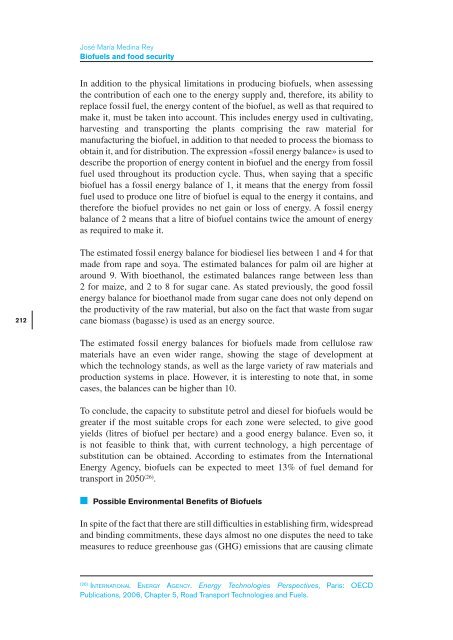Food security and global security - IEEE
Food security and global security - IEEE
Food security and global security - IEEE
- No tags were found...
You also want an ePaper? Increase the reach of your titles
YUMPU automatically turns print PDFs into web optimized ePapers that Google loves.
José María Medina ReyBiofuels <strong>and</strong> food <strong>security</strong>In addition to the physical limitations in producing biofuels, when assessingthe contribution of each one to the energy supply <strong>and</strong>, therefore, its ability toreplace fossil fuel, the energy content of the biofuel, as well as that required tomake it, must be taken into account. This includes energy used in cultivating,harvesting <strong>and</strong> transporting the plants comprising the raw material formanufacturing the biofuel, in addition to that needed to process the biomass toobtain it, <strong>and</strong> for distribution. The expression «fossil energy balance» is used todescribe the proportion of energy content in biofuel <strong>and</strong> the energy from fossilfuel used throughout its production cycle. Thus, when saying that a specificbiofuel has a fossil energy balance of 1, it means that the energy from fossilfuel used to produce one litre of biofuel is equal to the energy it contains, <strong>and</strong>therefore the biofuel provides no net gain or loss of energy. A fossil energybalance of 2 means that a litre of biofuel contains twice the amount of energyas required to make it.212The estimated fossil energy balance for biodiesel lies between 1 <strong>and</strong> 4 for thatmade from rape <strong>and</strong> soya. The estimated balances for palm oil are higher ataround 9. With bioethanol, the estimated balances range between less than2 for maize, <strong>and</strong> 2 to 8 for sugar cane. As stated previously, the good fossilenergy balance for bioethanol made from sugar cane does not only depend onthe productivity of the raw material, but also on the fact that waste from sugarcane biomass (bagasse) is used as an energy source.The estimated fossil energy balances for biofuels made from cellulose rawmaterials have an even wider range, showing the stage of development atwhich the technology st<strong>and</strong>s, as well as the large variety of raw materials <strong>and</strong>production systems in place. However, it is interesting to note that, in somecases, the balances can be higher than 10.To conclude, the capacity to substitute petrol <strong>and</strong> diesel for biofuels would begreater if the most suitable crops for each zone were selected, to give goodyields (litres of biofuel per hectare) <strong>and</strong> a good energy balance. Even so, itis not feasible to think that, with current technology, a high percentage ofsubstitution can be obtained. According to estimates from the InternationalEnergy Agency, biofuels can be expected to meet 13% of fuel dem<strong>and</strong> fortransport in 2050 (26) .■■Possible Environmental Benefits of BiofuelsIn spite of the fact that there are still difficulties in establishing firm, widespread<strong>and</strong> binding commitments, these days almost no one disputes the need to takemeasures to reduce greenhouse gas (GHG) emissions that are causing climate(26)International Energy Agency. Energy Technologies Perspectives, Paris: OECDPublications, 2006, Chapter 5, Road Transport Technologies <strong>and</strong> Fuels.
















